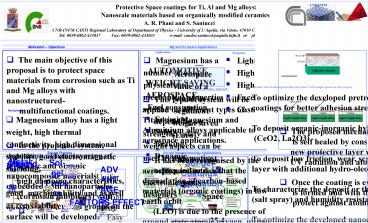DEVELOPMENT OF NANOPARTICLES WITH TUNABLE UV ABSORPTION CHARACTERISTICS - PowerPoint PPT Presentation
1 / 1
Title:
DEVELOPMENT OF NANOPARTICLES WITH TUNABLE UV ABSORPTION CHARACTERISTICS
Description:
Motivation Objectives Mg and its Space Applications Innovative approach ... energy to cleave organic bonds, which can bring about chain scission and ... – PowerPoint PPT presentation
Number of Views:104
Avg rating:3.0/5.0
Title: DEVELOPMENT OF NANOPARTICLES WITH TUNABLE UV ABSORPTION CHARACTERISTICS
1
Protective Space coatings for Ti, Al and Mg
alloys Nanoscale materials based on organically
modified ceramics
A. R. Phani and S. Santucci CNR-INFM
CASTI Regional Laboratory at Department of
Physics - University of LAquila, via Vetoio,
67010 Coppito, LAquila, ITALY
Tel 0039-0862-433037 Fax
0039-0862-433033 e-mail
sandro.santucci_at_aquila.infn.it or
phani_ayala_at_yahoo.com
Motivation
Objectives
Mg and its Space
Applications
Innovative approach
- The main objective of this proposal is to
protect space materials from corrosion such as Ti
and Mg alloys with nanostructured- - multifunctional coatings.
- In the proposed system, deposition of
nanolayering of inorganic and organic
nanocomposite materials embedded with
nanoparticles - (corrosion inhibitors) with additional
functional groups on the surface will be
developed. - These nanocomposite materials will be prepared
by simple, wet chemical processing system
(sol-gel process) at relatively low - temperatures (gt 150 C).
- The basic structure consists of inorganic
network with organic cross-linking or network
modifying structural units. A main advantage - of this system is the combination of
hardness (coming from the high amount of
inorganic network structures) and flexibility
(coming - from the nature and amount of cross linking
structures). - This could be possible by covalently bonding the
networks leading to stable functionalisation and
incorporating the corrosion inhibitor - nanoparticles with in these networks to have
corrosion resistance properties.
- Aerospace Value of a pound
in - segnment
weight saved (Euro) - Commercial --------------------
357 - Space -----------------------------
35.4 - Automobile ---------------------
1.78 3.2
- Radical Innovative Approach
- This type of system will be applied on
different types of Titanium, Magnesium and
Aluminium alloys applicable to aerospace
applications. - It has been recognised by the aerospace
industries that the degradation of carbon-based
materials (organic coatings) in low earth orbit - (LEO) is due to the presence of ground state
atomic oxygen, ultra-violet radiation and
vehicles extreme velocity. - The UV radiation that is present in low earth
orbit is of adequate energy to cleave organic
bonds, which can bring about chain scission and - cross-linking reactions in organic
polymeric materials. In addition to this, thermal
cycling, particulate radiation, vacuum, and - micrometeoroids and debris affect organic
materials. - In this respect, materials consisting of
inorganic/organic (polymer) can offer protection
from atomic oxygen as well as UV radiation and
high- - energy particles via the in situ
fabrication of nanophase silicon / metal-oxo
clusters. - Siloxane polymers, which have rates of erosion
one to two orders of magnitude slower than
organic polymers in low earth orbit, have been - chosen in the present investigation.
- In addition, to slower erosion rates, when
exposed to atomic oxygen siloxane polymers form
protective silicon oxide barrier.
Fig 1 Schematic diagram of the nanoscale hybrid
structure for multifunctional properties
for light-weight alloys applied for space
applications
Background
- Magnesium alloy has a light weight, high thermal
conductivity, high dimensional stability,
good electromagnetic shielding, - high damping characteristics, good
machineability and as well as recyclability - These properties make it valuable in a number of
applications including automobile, aerospace
components, mobile phones, - sporting goods, handheld tools, and
household equipment - The use of magnesium alloys can significantly
decrease the weight of automobiles without
sacrificing structural strength - Unfortunately, magnesium alloys have a number of
undesirable properties including poor corrosion
and wear resistance, poor - creep resistance, and high chemical
reactivity that have hindered its widespread use
in many applications
- The proposed mechanism explains where a space
debris erode a part of coating which - is self healed by consuming the atomic
oxygen present in the space, there by forming a - new protective layer which can withstand
both atomic oxygen degradation, high energy - UV radiation and atomic particles.
- Once the coating is exposed to atomic oxygen a
protective layer of silicon oxide - is formed and with the incorporation of
silicon-metal-oxy-clusters the coating should - protect against atomic oxygen erosion, high
energy particles, and deep UV radiation.
Sol-gel Process
Sol-gel Nanotechnology
Applications
Project Goals
Scientific and Technological Objectives that
CASTI might pursue in this project To optimize
the developed pretreatment process for light
weight alloys prior to the deposition of the
nanostructured coatings for better adhesion
strength To deposit organic-inorganic hybrid
nanocomposites embedded with functional corrosion
inhibitor nanoparticles (CeO2, La2O3) To
deposit low friction, wear, scratch, abrasion
resistant inorganic-polymer hybrid nanostructured
coatings as top layer with additional
hydro-oleophobic properties to fulfill the
objective of the multifunctional coatings. To
characterize the deposit or thermally treated
coatings for their structural, mechanical,
tribological and corrosion (salt spray) and
humidity resistance (intermittent, prohesion, and
condensation humidity tests) measurements. To
optimize the developed nanocomposites embedded
with nanoparticles for scale up process upon
dealing with the industrial partners in the
respective countries in the field of automobile,
aeronautic, construction and microelectronic
industries. Services offered by CASTI in the
project CASTI will analyze the coated samples
as well as corrosion resistance tested (salt
spray test) samples by employing full length
scale characterization techniques available in
the laboratory.































